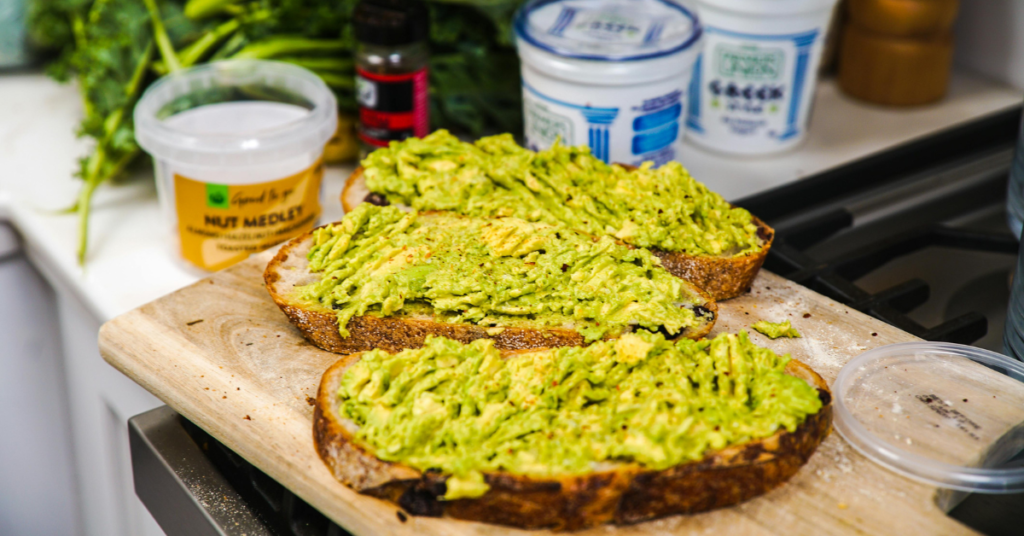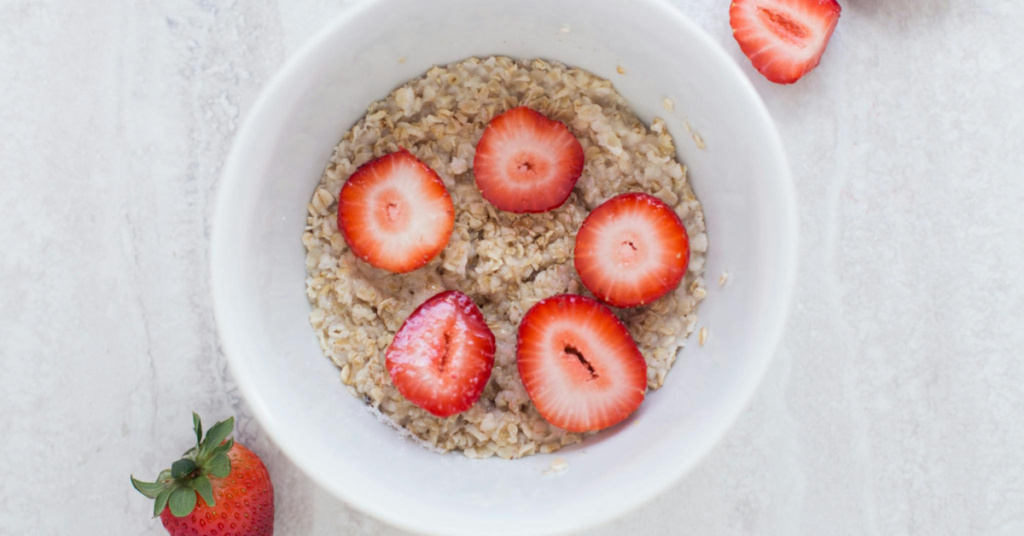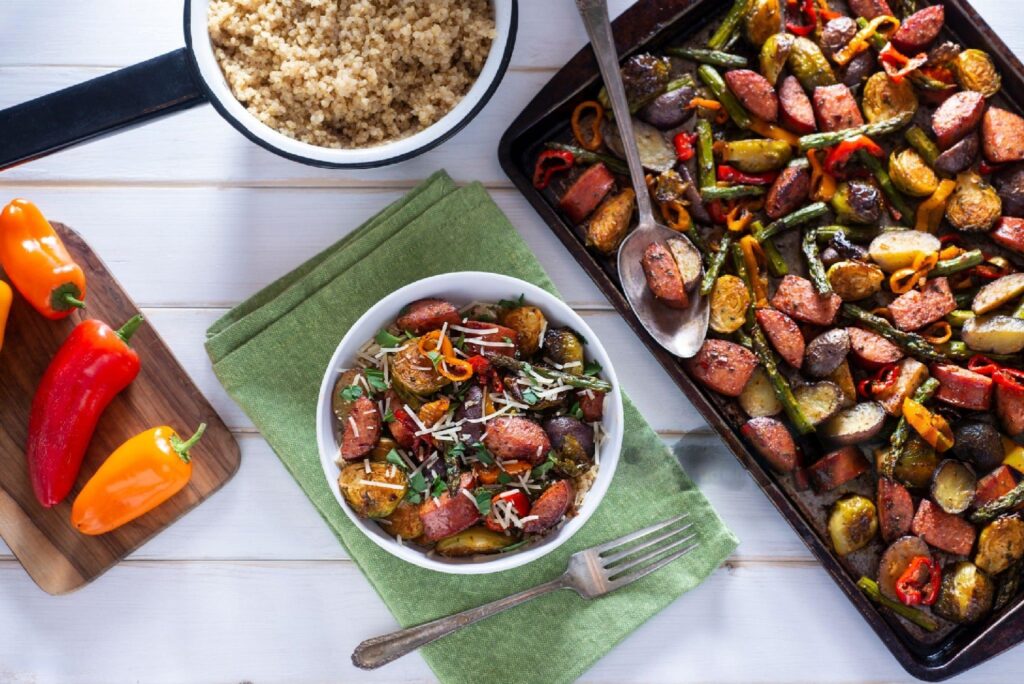With busy lifestyles and an endless list of tasks, cooking a healthy, delicious meal can sometimes feel like a daunting task. However, it doesn’t have to be! Here are the top ten low-effort cooking options that require minimal time and skill while providing maximum taste and nutrition. Whether you’re a student, a working professional, or simply someone looking to simplify mealtime, these recipes are perfect for you.

1. Avocado Toast
1.1 Why Avocado Toast?
Here is the first Low-Effort Cooking Foods, Avocado toast has become a breakfast staple and is beloved for many reasons. Let’s dive deeper into why this simple dish has captured so many’s hearts (and stomachs).

Nutritional Powerhouse
Avocado toast isn’t just trendy; it’s also packed with nutrients. Avocados are a great source of healthy fats, particularly monounsaturated fats, which are known for their heart-healthy benefits. These fats can help lower bad cholesterol levels and reduce the risk of heart disease. Additionally, avocados provide a good amount of fiber, vitamins C, E, K, and B6, and minerals like potassium and magnesium. Paired with whole-grain bread, avocado toast becomes a balanced meal rich in essential nutrients.
Customizable to Taste
One of the biggest appeals of avocado toast is its versatility. You can start with the basic version—mashed avocado on toast—and then customize it to suit your palate. Add a sprinkle of salt and pepper for simplicity, or elevate it with toppings like sliced tomatoes, a poached egg, smoked salmon, or microgreens. This adaptability makes it an excellent choice for different dietary preferences, from vegan to gluten-free, as it can be easily modified to fit various lifestyles.
Quick and Easy to Prepare
In our fast-paced world, convenience is key. Avocado toast checks this box by being incredibly easy and quick to prepare. All you need is a ripe avocado and a slice of your favorite bread. Toast the bread, mash the avocado, and you’re done. This simplicity makes it a perfect go-to meal for busy mornings or a quick snack when you’re on the go.
Aesthetically Pleasing
There’s no denying the visual appeal of avocado toast. Its vibrant green hue contrasted against a slice of golden-brown bread makes for a picture-perfect dish. This aesthetic appeal has made avocado toast a favorite subject for food bloggers and Instagram influencers, further popularizing it.
Supports a Balanced Diet
Avocado toast is a smart choice for those looking to maintain a balanced diet. It provides a good balance of carbohydrates, fats, and proteins, especially when paired with protein-rich toppings like eggs or seeds. This balance helps keep you full longer and supports sustained energy levels throughout the day.
In summary, avocado toast is a fantastic example of a meal that is both nutritious and delicious. Its ease of preparation, health benefits, and potential for customization make it a top choice for people looking for a satisfying yet simple meal.
2 Overnight Oats
2.1 The Benefits and Versatility of Overnight Oats
Overnight oats have soared in popularity as a quick, nutritious, and versatile breakfast option. Here’s an in-depth look at why overnight oats should be a staple in your breakfast routine.

Nutritional Benefits
Overnight oats are a nutritional powerhouse, providing a balanced blend of carbohydrates, protein, and fiber. Oats are a whole grain, meaning they contain the bran, germ, and endosperm, offering a host of health benefits. They are rich in beta-glucan, a type of soluble fiber that has been shown to reduce cholesterol levels, stabilize blood sugar, and promote a healthy gut microbiome.
By soaking oats overnight, their starches break down, making them easier to digest. This process also increases the bioavailability of nutrients, meaning your body can absorb more of the good stuff.
Ease of Preparation
One of the most significant advantages of overnight oats is their convenience. Preparation is as simple as mixing oats with a liquid (like milk or a dairy-free alternative), adding your choice of sweeteners, and mixing in your favorite toppings or flavorings. The mixture is left to soak in the refrigerator overnight, allowing the oats to absorb the liquid and soften.
This make-ahead feature means you can prepare breakfast the night before, saving you precious time in the morning. For those with hectic schedules, overnight oats are a lifesaver, providing a quick, grab-and-go option that doesn’t sacrifice nutrition.
Customizable Flavors
The versatility of overnight oats is another major draw. Whether you prefer a sweet or savory start to your day, you can tailor overnight oats to your taste. Here are a few ideas to inspire you:
- Classic Fruit and Nut: Combine oats with almond milk, a touch of honey, chopped almonds, and fresh berries.
- Chocolate Delight: Mix oats with chocolate milk, a scoop of Greek yogurt, a sprinkle of cocoa powder, and top with banana slices.
- Tropical Twist: Use coconut milk as your base and add diced mango, pineapple, and shredded coconut.
These variations can be easily adjusted to fit dietary needs or preferences, such as gluten-free oats, non-dairy milk, or natural sweeteners.
Sustainable and Cost-Effective
Oats are an affordable ingredient, and buying them in bulk can make them even more cost-effective. Since they have a long shelf life, you can stock up without worrying about spoilage. Additionally, overnight oats reduce the need for single-use packaging, as you can prepare them in reusable containers, making them a more sustainable breakfast choice.
A Balanced Breakfast Option
Overnight oats provide a good balance of macronutrients and can be enhanced with various add-ins to increase their nutritional profile. Add a scoop of protein powder or nut butter for extra protein, or sprinkle in chia seeds or flaxseeds for healthy fats and additional fiber.
In conclusion, overnight oats are an excellent breakfast choice that combines convenience, nutrition, and versatility. By incorporating overnight oats into your diet, you can enjoy a delicious and healthful start to your day without the morning rush.
3. Sheet Pan Dinners
3.1 The Simplicity and Variety of Sheet Pan Dinners
Sheet pan dinners are the epitome of convenience and culinary creativity, offering a solution to busy weeknights without compromising on flavor or nutrition. Here’s why sheet pan dinners are a fantastic addition to your meal rotation.

One-Pan Convenience
The primary appeal of sheet pan dinners is the minimal cleanup. By cooking your entire meal on a single pan, you reduce the number of dishes and kitchen tools that need to be washed. This streamlined approach not only saves time but also keeps your kitchen tidy and organized.
Endless Customization
Sheet pan dinners are incredibly versatile, accommodating a wide variety of ingredients and dietary preferences. Whether you’re in the mood for a hearty meat and vegetable combo or a plant-based feast, you can tailor your sheet pan dinner to your liking. Some popular combinations include:
- Chicken and Vegetables: Season chicken breasts or thighs with your favorite spices and surround them with a colorful array of vegetables like bell peppers, zucchini, and carrots.
- Salmon and Asparagus: A classic pairing, this dish requires minimal seasoning—just a touch of lemon, garlic, and olive oil to enhance the natural flavors.
- Tofu and Broccoli: Marinate tofu in a soy-ginger sauce and roast with broccoli florets for a simple yet satisfying vegan meal.
Balanced and Nutritious
Sheet pan dinners are a great way to ensure a balanced meal. By combining protein, vegetables, and healthy fats in one dish, you create a well-rounded meal that satisfies dietary needs. The roasting process also helps retain the nutrients in your ingredients, providing a wholesome and flavorful dinner.
Quick and Easy Preparation
Preparing a sheet pan dinner is straightforward. Start by preheating your oven, then arrange your ingredients on the sheet pan. To ensure even cooking, place items that take longer to cook, like denser vegetables or thicker cuts of meat, on the pan first. Add quicker-cooking items, like leafy greens or delicate fish, halfway through the cooking process.
This method allows you to have dinner on the table in under an hour, making it a perfect choice for weeknight meals.
Suitable for All Skill Levels
Whether you’re a novice cook or a seasoned chef, sheet pan dinners are easy to master. The basic principles remain the same: choose your ingredients, season them, and let the oven do the work. This simplicity allows for creativity and experimentation without the pressure of complex cooking techniques.
Budget-Friendly
Sheet pan dinners can be as economical as they are delicious. Using seasonal produce and affordable cuts of meat or plant-based proteins, you can create meals that are light on the wallet but heavy on flavor. This approach makes sheet pan dinners an excellent option for families or anyone looking to save money without sacrificing taste.
Conclusion
Sheet pan dinners are a game-changer for those seeking quick, nutritious, and flavorful meals. Their ease of preparation, minimal cleanup, and adaptability make them a go-to option for busy weeknights or any time you want a fuss-free meal. By incorporating a variety of ingredients and flavors, you can keep your dinners exciting and your taste buds satisfied.
4. Smoothie Bowls
4.1 The Appeal and Benefits of Smoothie Bowls
Smoothie bowls have become a staple in the health and wellness community for their vibrant colors, nutrient density, and delicious flavors. They combine the convenience of a smoothie with the satisfaction of a more substantial meal, making them a fantastic option for breakfast, lunch, or a nutritious snack. Let’s explore the allure of smoothie bowls and why they’ve become a go-to for health enthusiasts.

Nutrient-Dense and Balanced
One of the primary benefits of smoothie bowls is their ability to pack a wide range of nutrients into a single meal. By blending fruits, vegetables, and other healthy ingredients, you create a balanced mix of carbohydrates, fiber, vitamins, and minerals. Smoothie bowls can also be tailored to include protein sources like Greek yogurt, protein powder, or nuts, making them a complete meal that supports muscle recovery and keeps you feeling full longer.
Versatility and Customization
Smoothie bowls are incredibly versatile and can be customized to fit any dietary preference or nutritional goal. Whether you’re vegan, gluten-free, or following a specific dietary plan, you can easily adapt smoothie bowl recipes to meet your needs. Here are a few ideas to inspire your creations:
- Berry Blast: Blend strawberries, blueberries, and raspberries with a splash of almond milk. Top with granola, chia seeds, and a drizzle of honey.
- Green Goddess: Mix spinach, kale, banana, and avocado with coconut water. Garnish with sliced kiwi, hemp seeds, and coconut flakes.
- Tropical Paradise: Combine mango, pineapple, and banana with coconut milk. Add toppings like sliced banana, goji berries, and crushed pistachios.
A Feast for the Eyes
Part of the charm of smoothie bowls lies in their visual appeal. The vibrant colors and artful arrangement of toppings make them as beautiful as they are tasty. This aesthetic quality makes smoothie bowls a popular choice for social media posts, where they often feature intricate designs and creative topping combinations.
Easy and Quick Preparation
Despite their gourmet appearance, smoothie bowls are surprisingly easy and quick to prepare. All you need is a blender and a few fresh ingredients. Once you’ve blended your base, you can let your creativity shine by adding your favorite toppings. This quick preparation time makes smoothie bowls an ideal option for those busy mornings when you need a nutritious meal without the fuss.
Boosting Hydration and Fiber Intake
Smoothie bowls are an excellent way to boost hydration and fiber intake. Fruits and vegetables are naturally high in water content, helping you stay hydrated throughout the day. Additionally, the fiber in these ingredients supports healthy digestion, promotes satiety, and helps maintain steady blood sugar levels.
Encouraging Healthy Eating Habits
Incorporating smoothie bowls into your diet can help establish healthy eating habits. By prioritizing whole, nutrient-dense foods, you’re more likely to make healthier choices throughout the day. Smoothie bowls also provide an opportunity to experiment with new fruits, vegetables, and superfoods, expanding your palate and nutritional intake.
Conclusion
Smoothie bowls are more than just a trend; they are a nutritious and delicious way to fuel your body. With their vibrant colors, endless customization options, and health benefits, smoothie bowls are a delightful addition to any diet. Whether you’re looking for a quick breakfast, a post-workout meal, or a refreshing snack, smoothie bowls offer a perfect blend of taste and nutrition.
5. Stir-Fry Meals
Mastering the Basics of Quick Stir-Fry
Stir-frying is a versatile and speedy cooking technique that brings out the flavors of your ingredients while maintaining their nutritional value. Perfect for busy weeknights or when you’re craving something both healthy and satisfying, stir-fries can be easily customized to your taste. Here’s a guide to the basics of quick stir-fry to help you whip up a delicious meal in no time.

Choosing the Right Ingredients
A great stir-fry starts with fresh and quality ingredients. Here’s what you’ll need:
- Protein: Choose from chicken, beef, pork, tofu, shrimp, or tempeh. Cut the protein into bite-sized pieces for even cooking.
- Vegetables: Opt for a mix of colors and textures. Common choices include bell peppers, broccoli, carrots, snap peas, mushrooms, and baby corn. Cut vegetables into uniform sizes to ensure even cooking.
- Aromatics: Garlic, ginger, and green onions are essential for adding depth and flavor.
- Sauce: The sauce can be as simple or complex as you like. Soy sauce, oyster sauce, hoisin sauce, and sesame oil are staples, but feel free to experiment with different combinations and additions like chili sauce, rice vinegar, or honey.
- Garnishes: Fresh herbs, sesame seeds, or chopped nuts add a finishing touch.
Preparation and Mise en Place
Preparation is key to a successful stir-fry. Have all your ingredients chopped and measured before you start cooking. This ensures a smooth cooking process, as stir-frying is a fast-paced technique that requires your full attention.
The Right Equipment
A wok is the traditional tool for stir-frying, thanks to its shape and ability to distribute heat evenly. However, a large, heavy skillet will also work if you don’t have a wok. Make sure your pan is large enough to allow for easy tossing and stirring.
Cooking Techniques
- Heat the Pan: Start by heating your wok or skillet over high heat. The pan should be very hot before you add any ingredients to ensure a good sear and prevent sticking.
- Add Oil: Use an oil with a high smoke point, such as canola, peanut, or sunflower oil. Swirl the oil around to coat the pan.
- Cook Protein: Add the protein and spread it out in a single layer. Allow it to sear for a minute or two before stirring, then cook until it’s about 80% done. Remove the protein from the pan and set it aside.
- Stir-Fry Vegetables: Add more oil if needed, then toss in the aromatics (garlic, ginger, etc.) and cook for 30 seconds until fragrant. Add the vegetables in order of cooking time, starting with those that take the longest. Stir-fry until the vegetables are crisp-tender.
- Combine and Sauce: Return the protein to the pan. Pour in your sauce and stir everything together. Continue to cook for a couple of minutes until everything is coated in the sauce and cooked through.
- Finish and Serve: Turn off the heat and transfer the stir-fry to a serving dish. Top with your choice of garnishes and serve immediately.
Tips for a Perfect Stir-Fry
- Work Quickly: Stir-frying is a fast cooking method, so move quickly to prevent burning or overcooking.
- Don’t Overcrowd the Pan: Cooking in batches if necessary to ensure each ingredient gets enough heat and space to cook properly.
- Taste as You Go: Adjust the seasonings and sauce as you cook to suit your preferences.
Conclusion
Stir-frying is a quick and healthy way to prepare a flavorful meal. With these basics in mind, you can easily customize your stir-fry to suit your taste and dietary needs. Whether you’re a seasoned cook or a kitchen novice, mastering the art of stir-fry can add a versatile and enjoyable dish to your culinary repertoire.
Read More: Top 5 Healthy Morning Breakfasts for a Nutritious Start








